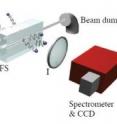Simulating black hole radiation with lasers
Related images
(click to enlarge)
A team of Italian scientists has fired a laser beam into a hunk of glass to create what they believe is an optical analogue of the Hawking radiation that many physicists expect is emitted by black holes. Although the laser experiment superficially bears little resemblance to ultra-dense black holes, the mathematical theories used to describe both are similar enough that confirmation of laser-induced Hawking radiation would bolster confidence that black holes also emit Hawking radiation. When Stephen Hawking first predicted the radiation bearing his name in 1974, he hypothesized that photons could be spontaneously generated from the vacuum at the edge of a black hole. However, Hawking radiation emitted from a black hole would be so weak that many scientists believe it to be nearly impossible to detect.
Scientists have turned to lasers before in attempts to create Hawking radiation, but have had difficulty isolating Hawking radiation from other forms of light emitted during experiments. Franco Belgiorno et al. combined a tunable laser beam with a bulk glass target, which allowed them to limit the Hawking radiation to certain wavelengths of infrared light and to capture the apparent Hawking radiation with an infrared sensitive digital camera.
A paper describing the possible production of a laser induced analogue of Hawking radiation appears in the current issue of Physical Review Letters, and is the subject of a Viewpoint article by John Dudley (CNRS, France) and Dmitry Skryabin (University of Bath, UK) in this week's edition of Physics (physics.aps.org).
Source: American Physical Society
Other sources
- Physicists Create Black Hole 'Light' in Labfrom Science NOWFri, 12 Nov 2010, 21:20:10 UTC
- Huge Bubbles Found at Milky Way's Heart Could Signal a Black Hole Eruptionfrom Space.comTue, 9 Nov 2010, 22:01:17 UTC
- ‘Bonsai radio quasar’ foundfrom Science AlertTue, 9 Nov 2010, 13:20:59 UTC
- Simulating black hole radiation with lasers: Lasers produce the first Hawking radiation ever detectedfrom Science DailyMon, 8 Nov 2010, 23:30:33 UTC
- Scientists use light signatures to track merging supermassive black holesfrom PhysorgMon, 8 Nov 2010, 18:30:47 UTC
- Simulating black hole radiation with lasersfrom Science BlogMon, 8 Nov 2010, 17:10:31 UTC
- Simulating black hole radiation with lasersfrom PhysorgMon, 8 Nov 2010, 17:00:24 UTC
